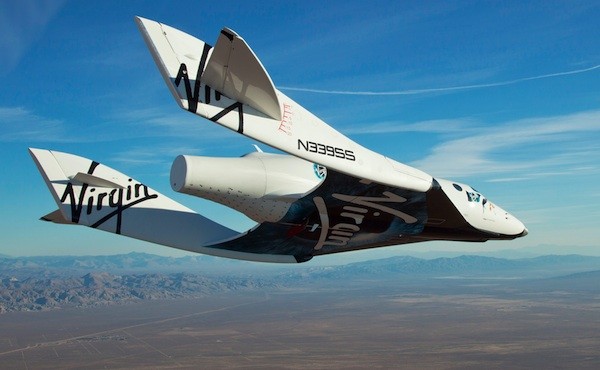
Virgin Galactic, the private space company that aims to become the first commercial spaceliner in the world, kicked 2014 into high gear with the third successful powered supersonic test flight of SpaceShip Two on Jan. 10.
SpaceShip Two is Virgin’s purposely built reusable spaceplane, meant to take paying passengers in suborbital flights above the Earth’s atmosphere at altitudes higher than the Kármán line, which is the commonly accepted boundary between Earth’s atmosphere and space, 62 miles (100 km) above sea level. Although SpaceShip Two lacks the ability to reach orbit, it will nevertheless offer approximately six minutes of weightlessness to its passengers, going as high as 110 km above the Earth before re-entering the atmosphere. The spaceplane will not be launched from the ground all by itself, but it will be carried by a bigger mothership called WhiteKnight Two, which will lift it to an altitude of approximately 50,000 ft. Once there, SpaceShip Two will be released, prior to igniting its hybrid rocket motor and achieving supersonic velocities to ascend above the atmosphere. Following a ballistic trajectory, it will then come back to Earth, gliding toward an unpowered, runaway landing, in the same way that NASA’s space shuttle was returning from orbit during the program’s 30-year history.
Fresh off the success of two similar test flights in 2013, Virgin Galactic conducted the third supersonic, powered test flight of SpaceShip Two on Jan. 10, at the skies above Spaceport America in New Mexico where the spaceplane is currently undergoing its flight test program. After taking off from the Spaceport’s 12,000-foot (3,660-m) runaway, at 7:22 a.m. local time, the WhiteKnight Two carrier, named “Eve,” lifted the SpaceShip Two “Enterprise” to an altitude of 46,000 feet. There, the spaceplane was released, making a free-fall for several seconds, prior to igniting its rocket engine for a 20-second burn that propelled it to an altitude of 71,000 feet—the planned altitude for this third flight test. Having achieved its goal by reaching a maximum speed of 1.4 Mach, the successful flight test was concluded approximately 20 minutes afterward, with SpaceShip Two safely gliding on the Spaceport’s runaway.
http://www.youtube.com/watch?v=pwm3leZu-O0Video Credit: Virgin Galactic
“I couldn’t be happier to start the New Year with all the pieces visibly in place for the start of full space flights,” said Richard Branson, billionaire entrepreneur and founder of Virgin Galactic after the flight. “2014 will be the year when we will finally put our beautiful spaceship in her natural environment of space. Today, we had our own Chief Pilot flying another flawless supersonic flight and proving the various systems required to take us safely to space, as well as providing the very best experience while we’re up there.”
Virgin’s chief pilot, Dave Mackay, was at the controls of SpaceShip Two for the first time during a flight test, alongside Mark Stucky, test pilot for Scaled Composites. Scaled Composites, founded by aerospace engineer Burt Rutan, had been the company that designed and built the experimental spacecraft SpaceShip One, which went on to win the Ansari X Prize in 2004 by conducting the first-ever consecutive private manned spaceflights within a week. Rutan later went on with Branson to form The Spaceship Company (TSC) that designed and built the successor to SpaceShip One, SpaceShip Two, alongside the WhiteKnight Two mothership, which comprises Virgin Galactic’s fleet of reusable suborbital vehicles.
“I have watched SS2 evolve over the years into an incredible vehicle that is going to open up space to more people than ever before,” said a jubilant Mackay, following the recent successful flight. “To be behind the controls and fly it as the rocket ignited is something I will never forget. She flew brilliantly. All the tests went really well and generated vital data that will be used to further fine-tune our operations.”
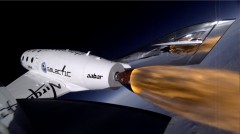
In addition to surpassing the altitudes achieved during the two previous test flights in April and October 2013 respectively, the Jan. 10 flight also successfully tested some of the vehicle’s key components, like the reaction control systems (RCS) and the thermal protection coating covering the spaceplane’s inner tail boom. The RCS is comprised of a series of thrusters that will allow the pilots to maneuver SpaceShip Two when on its higher point in its orbit outside of the Earth’s atmosphere. It will also give them the ability to spin the spaceplane, allowing for the best viewing conditions for passengers to gaze at the Earth’s curvature.
“Today’s flight was another resounding success,” said George Whitesides, Virgin’s CEO, at release following the test. “We focused on gathering more transonic and supersonic data, and our chief pilot, Dave, handled the vehicle beautifully. With each flight test, we are progressively closer to our target of starting commercial service in 2014.”
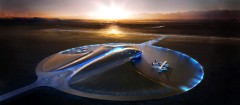
The start of commercial operations has been a long-postponed milestone for the company. A year after the Ansari X Prize, Richard Branson had declared that the first commercial flights onboard SpaceShip Two would commence around 2008, with the starting date being pushed back continuously. A major setback occurred in 2007 when Scaled Composites was testing its hybrid propellant rocket engine for SpaceShip Two, called RocketMotor Two, at the Mojave Air and Space Port in California. During a routine test, a fuel tank containing nitrous oxide suddenly exploded, killing three company employees and seriously injuring three more.
The hybrid rocket engine used on SpaceShip Two had been developed by Sierra Nevada Corp. and is also used on the Sierra’s Dream Chaser, the spacecraft that aims to transfer crew and cargo to and from the International Space Station, under NASA’s Commercial Crew program. Hybrid propulsion uses a mixture of nitrous oxide and synthetic rubber which is considered by many to be much safer and easier to use than conventional liquid and solid rocket fuels. Yet, others remain skeptical. “The oft-repeated claim that hybrids can’t blow up is a canard—they can and do,” says Gary C. Hudson, president of the Space Studies Institute in Mojave, Calif. “A hybrid doesn’t worry me more or less than any other rocket. Any type of engine is intolerant of sloppiness.”
“This vehicle is designed to go into the atmosphere in the worst case straight in or upside down and it’ll correct,” commented Burt Rutan, in 2008, on the overall safety of SpaceShip Two. “This is designed to be at least as safe as the early airliners in the 1920s. Don’t believe anyone that tells you that the safety will be the same as a modern airliner, which has been around for 70 years.”
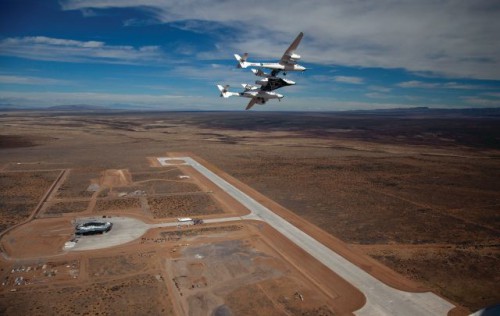
Following the accident, Scaled continued testing on RocketMotor Two, successfully completing a series of dozens of ground hot-fire tests that led to SpaceShip Two’s three powered supersonic flights. After the recent test-flight successes, Branson is confident and optimistic that by the end of 2014, his company will at last make history by becoming the first commercial spaceline company in the world. Yet, before that time comes, Virgin has a lot of ground to cover. Although the latest flight test in January saw SpaceShip Two’s engine ignite for 20 seconds, a full duration firing of 60 seconds is required for the spaceplane to achieve the needed altitude of 361,000 feet (110 km). Upcoming flight tests during the year aim to bridge that gap, prior to allowing Branson and his two children, Holly and Sam, to board SpaceShip Two for its first manned suborbital flight test.
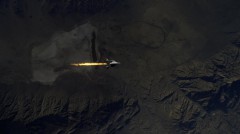
Branson also reached an agreement in late 2013 with NBC News for this first flight to be carried live on television, helping to promote commercial private spaceflight to a wider audience. “In this first chapter of commercial space travel, we will help make space accessible and inspire countless more people to join us in the pursuit of space exploration and science innovation,” said Branson after the agreement with the TV broadcast network.
Until now, around 640 people have signed up for a trip onboard SpaceShip Two, according to Virgin Galactic, among whom are many notable personalities from the music and movie industry, like Justin Bieber, Lady Gaga, Aston Kutcher, Leonardo DiCaprio, Brad Pitt, and Angelina Jolie. One of the most notable names on the list, though, is that of celebrated astrophysicist Stephen Hawking, a known advocate of space exploration and settlement. In contrast to all the other potential passengers, Hawking also has some zero-g experience, having made a shortened flight onboard a “Vomit Comet” aircraft in 2007, conducted by Zero Gravity Corporation.
The celebrity names populating the list of future passengers on Virgin Galactic’s flights is no coincidence either—a ticket for a ride onboard SpaceShip Two currently costs $250,000. According to Branson, the prices will start going down, but only after the first 1,000 passengers have flown.
Provided that everything goes according to plan, Branson believes the first suborbital flight will take place around August of this year. Barring any unexpected anomalies, it may be that 2014 will be the breakthrough year for suborbital space tourism, exactly 10 years after Burt Rutan claimed the Ansari X Prize with SpaceShip One, opening a new era—the era of commercial spaceflight.
Want to keep up-to-date with all things space? Be sure to “Like” AmericaSpace on Facebook and follow us on Twitter: @AmericaSpace




Actually my comment is question. Where can I find information regarding the selection process and information regarding the third group of Astronauts selected by NASA in October 1963. I apprciate any assistance you can provide.
Hello Gregory,
You can find many sources of information on the web, concerning NASA’s astronaut class of 1963. The best place to start, is the Index page of NASA’s own History Program Office. In the Index link above, you can find info on the selection criteria for all of NASA’s astronaut classes. The History Program Office’s site is full of highly educational and informative material as well.
There are many books written about astronauts also, that you could read. The first that come to mind are Matthew H. Hersch’s recently published “Inventing the American Astronaut”, published by Palgrave MacMillan, and “Escaping the Bonds of Earth: The Fifties and the Sixties” by AmericaSpace’s writer Ben Evans, published by Springer-Praxis.
Happy reading!